
Slat and what it does inside our body
Salt...NaCl = Sodium Chloride
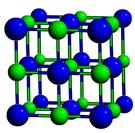
Sodium Chloride
The classic case of ionic bonding, the sodium chloride molecule forms by the ionization of sodium and chlorine atoms and the attraction of the resulting ions.
An atom of sodium has one 3s electron outside a closed shell, and it takes only 5.14 electron volts of energy to remove that electron. The chlorine lacks one electron to fill a shell, and releases 3.62 eV when it acquires that electron (it's electron affinity is 3.62 eV). This means that it takes only 1.52 eV of energy to donate one of the sodium electrons to chlorine when they are far apart. When the resultant ions are brought closer together, their electric potential energy becomes more and more negative, reaching -1.52 eV at about 0.94 nm separation. This means that if neutral sodium and chlorine atoms found themselves closer than 0.94 nm, it would be energetically favorable to transfer an electron from Na to Cl and form the ionic bond.
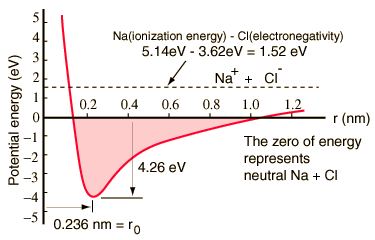
The potential energy curve shows that there is a minimum at 0.236 nm separation and then a steep rise in potential which represents a repulsive force. This repulsive force is more than just an electrostatic repulsion between the electron clouds of the two atoms. It has a quantum mechanical character rooted in the Pauli exclusion principle, and is often called just the "exclusion principle repulsion". When the ions are widely separated, the wavefunctions of their core electrons do not significantly overlap and they can have identical quantum numbers. As they get closer, the increasing overlap of the wavefunctions causes some to be forced into higher energy states. No two electrons can occupy the same state, so as a new set of energy states is formed for the composite, two-nucleus system, the lower energy states are filled and some of the electrons are pushed into higher states. This requires energy and is experienced as a repulsion, preventing the ions from coming any closer to each other.
The potential diagram above is for gaseous NaCl, and the environment is different in the normal solid state where sodium chloride (common table salt) forms cubical crystals. The ion separation is 0.28 nm, somewhat larger than that in the gaseous state.
A major part of the study of molecular structure is the description of the chemical bonds which are formed between atoms. The classic studies are the extremes of ionic bonding in sodium chloride and covalent bonding in the hydrogen molecule.
Molecular Spectra
The most commonly observed molecular spectra involve electronic, vibrational, or rotational transitions. For a diatomic molecule, the electronic states can be represented by plots of potential energy as a function of internuclear distance. Electronic transitions are vertical or almost vertical lines on such a plot since the electronic transition occurs so rapidly that the internuclear distance can't change much in the process. Vibrational transitions occur between different vibrational levels of the same electronic state. Rotational transitions occur mostly between rotational levels of the same vibrational state, although there are many examples of combination vibration-rotation transitions for light molecules.

Chemical Bonding
Chemical compounds are formed by the joining of two or more atoms. A stable compound occurs when the total energy of the combination has lower energy than the separated atoms. The bound state implies a net attractive force between the atoms ... a chemical bond. The two extreme cases of chemical bonds are:
Covalent bond: bond in which one or more pairs of electrons are shared by two atoms.
Ionic bond: bond in which one or more electrons from one atom are removed and attached to another atom, resulting in positive and negative ions which attract each other.
Other types of bonds include metallic bonds and hydrogen bonding. The attractive forces between molecules in a liquid can be characterized as van der Waals bonds.
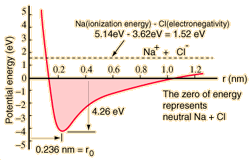 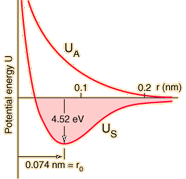
Covalent Bonds
Covalent chemical bonds involve the sharing of a pair of valence electrons by two atoms, in contrast to the transfer of electrons in ionic bonds. Such bonds lead to stable molecules if they share electrons in such a way as to create a noble gas configuration for each atom.
Hydrogen gas forms the simplest covalent bond in the diatomic hydrogen molecule. The halogens such as chlorine also exist as diatomic gases by forming covalent bonds. The nitrogen and oxygen which makes up the bulk of the atmosphere also exhibits covalent bonding in forming diatomic molecules.
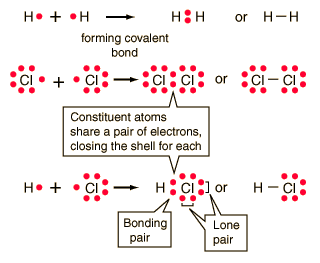
Covalent bonding can be visualized with the aid of Lewis diagrams.
Polar Covalent Bonds
Covalent bonds in which the sharing of the electron pair is unequal, with the electrons spending more time around the more nonmetallic atom, are called polar covalent bonds. In such a bond there is a charge separation with one atom being slightly more positive and the other more negative, i.e., the bond will produce a dipole moment. The ability of an atom to attract electrons in the presense of another atom is a measurable property called electronegativity.
Ionic Bonds
In chemical bonds, atoms can either transfer or share their valence electrons. In the extreme case where one or more atoms lose electrons and other atoms gain them in order to produce a noble gas electron configuration, the bond is called an ionic bond.
Typical of ionic bonds are those in the alkali halides such as sodium chloride, NaCl.
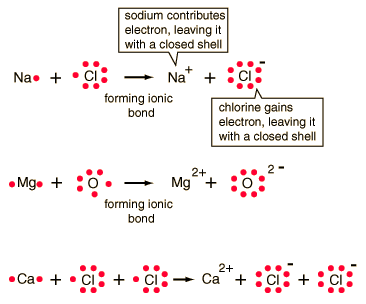
Ionic bonding can be visualized with the aid of Lewis diagrams.
Hydrogen Bonding
Hydrogen bonding differs from other uses of the word "bond" since it is a force of attraction between a hydrogen atom in one molecule and a small atom of high electronegativity in another molecule. That is, it is an intermolecular force, not an intramolecular force as in the common use of the word bond.
When hydrogen atoms are joined in a polar covalent bondwith a small atom of high electronegativity such as O, F or N, the partial positive charge on the hydrogen is highly concentrated because of its small size. If the hydrogen is close to another oxygen, fluorine or nitrogen in another molecule, then there is a force of attraction termed a dipole-dipole interaction. This attraction or "hydrogen bond" can have about 5% to 10% of the strength of a covalent bond.
Hydrogen bonding has a very important effect on the properties of water and ice. Hydrogen bonding is also very important in proteins and nucleic acids and therefore in life processes. The "unzipping" of DNA is a breaking of hydrogen bonds which help hold the two strands of the double helix together.

Ionic bonding can be visualized with the aid of Lewis diagrams.
Metallic Bonds
The properties of metals suggest that their atoms possess strong bonds, yet the ease of conduction of heat and electricity suggest that electrons can move freely in all directions in a metal. The general observations give rise to a picture of "positive ions in a sea of electrons" to describe metallic bonding.
Metal Properties
The general properties of metals include malleability and ductility and most are strong and durable. They are good conductors of heat and electricity. Their strength indicates that the atoms are difficult to separate, but malleability and ductility suggest that the atoms are relatively easy to move in various directions. The electrical conductivity suggests that it is easy to move electrons in any direction in these materials. The thermal conductivity also involves the motion of electrons. All of these properties suggest the nature of the metallic bonds between atoms.
So What does all this mean?
It basically means that if we want to keep our body healthy, especially in our older years, we should avoid salts whenever posssible as it is basically only a taste bud arouser and causes our bodies to crave what we have placed it on or in, eventually encouraging us to overindulge.
Reference: Tipler Elementary Modern Physics, Chapter 5
|